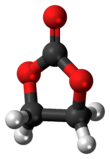Ethylene carbonate
|
|
|||
| Names | |||
|---|---|---|---|
|
IUPAC name
1,3-dioxolan-2-one
|
|||
| Other names
ethylene glycol carbonate
|
|||
| Identifiers | |||
|
96-49-1 |
|||
| 3D model (Jmol) | Interactive image | ||
| ChemSpider |
7030 |
||
| ECHA InfoCard | 100.002.283 | ||
| PubChem | 7303 | ||
|
|||
|
|||
| Properties | |||
| C3H4O3 | |||
| Molar mass | 88.06 g·mol−1 | ||
| Appearance | White to yellow solid | ||
| Density | 1.3210 g/cm3 | ||
| Melting point | 34 to 37 °C (93 to 99 °F; 307 to 310 K) | ||
| Boiling point | 243.0 °C (469.4 °F; 516.1 K) | ||
| Soluble | |||
| Hazards | |||
| Safety data sheet | External MSDS | ||
|
EU classification (DSD)
|
Irritant (XI) | ||
| R-phrases | R41 | ||
| S-phrases | S26 S39 | ||
| Flash point | 150 °C (302 °F; 423 K) | ||
| 465 °C (869 °F; 738 K) | |||
|
Except where otherwise noted, data are given for materials in their standard state (at 25 °C [77 °F], 100 kPa).
|
|||
|
|
|||
| Infobox references | |||
Ethylene carbonate is the organic compound with the formula (CH2O)2CO. It is classified as the carbonate ester of ethylene glycol and carbonic acid. At room temperature (25 °C) ethylene carbonate is a transparent crystalline solid, practically odorless and colorless, and somewhat soluble in water. In the liquid state (m.p. 34-37 °C) it is a colorless odorless liquid.
Ethylene carbonate is produced by the reaction between ethylene oxide and carbon dioxide. The reaction is catalyzed by a variety of cations and complexes:
Ethylene carbonate (and propylene carbonate) may be converted to dimethyl carbonate (a useful solvent and a mild methylating agent) via transesterification by methanol:
Dimethyl carbonate may itself be similarly transesterified to diphenyl carbonate, a phosgene-substitute:
Ethylene carbonate is used as a polar solvent with a molecular dipole moment of 4.9 D, only 0.1 D lower than that of propylene carbonate. It can be used as a high permittivity component of electrolytes in lithium batteries.
Ethylene carbonate is also used as plasticizer, and as a precursor to vinylene carbonate, which is used in polymers and in organic synthesis.
...
Wikipedia


